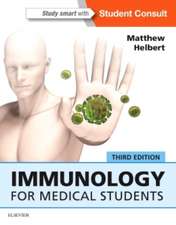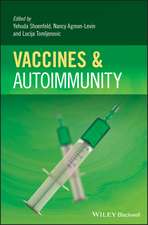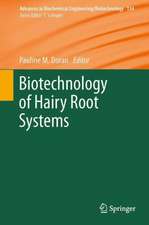Invertebrate Immunology: Progress in Molecular and Subcellular Biology, cartea 15
Editat de B. Rinkevich, W.E.G. Mülleren Limba Engleză Paperback – 27 dec 2011
Din seria Progress in Molecular and Subcellular Biology
- 18%
 Preț: 1115.46 lei
Preț: 1115.46 lei - 18%
 Preț: 1403.04 lei
Preț: 1403.04 lei - 18%
 Preț: 1112.30 lei
Preț: 1112.30 lei - 18%
 Preț: 1117.03 lei
Preț: 1117.03 lei - 18%
 Preț: 1222.49 lei
Preț: 1222.49 lei - 18%
 Preț: 1382.21 lei
Preț: 1382.21 lei - 18%
 Preț: 1232.26 lei
Preț: 1232.26 lei - 18%
 Preț: 1222.80 lei
Preț: 1222.80 lei - 24%
 Preț: 1045.93 lei
Preț: 1045.93 lei - 18%
 Preț: 956.50 lei
Preț: 956.50 lei -
 Preț: 387.20 lei
Preț: 387.20 lei - 15%
 Preț: 639.73 lei
Preț: 639.73 lei - 15%
 Preț: 633.19 lei
Preț: 633.19 lei - 15%
 Preț: 634.18 lei
Preț: 634.18 lei - 15%
 Preț: 634.00 lei
Preț: 634.00 lei - 15%
 Preț: 640.24 lei
Preț: 640.24 lei - 15%
 Preț: 634.32 lei
Preț: 634.32 lei - 15%
 Preț: 637.28 lei
Preț: 637.28 lei - 15%
 Preț: 637.78 lei
Preț: 637.78 lei - 15%
 Preț: 637.28 lei
Preț: 637.28 lei - 15%
 Preț: 649.06 lei
Preț: 649.06 lei -
 Preț: 387.75 lei
Preț: 387.75 lei - 18%
 Preț: 1220.75 lei
Preț: 1220.75 lei - 18%
 Preț: 1224.99 lei
Preț: 1224.99 lei - 18%
 Preț: 946.87 lei
Preț: 946.87 lei - 15%
 Preț: 633.35 lei
Preț: 633.35 lei - 18%
 Preț: 944.36 lei
Preț: 944.36 lei -
 Preț: 387.96 lei
Preț: 387.96 lei - 15%
 Preț: 633.02 lei
Preț: 633.02 lei - 15%
 Preț: 640.88 lei
Preț: 640.88 lei - 5%
 Preț: 720.10 lei
Preț: 720.10 lei
Preț: 714.27 lei
Preț vechi: 751.86 lei
-5% Nou
Puncte Express: 1071
Preț estimativ în valută:
136.69€ • 148.43$ • 114.82£
136.69€ • 148.43$ • 114.82£
Carte tipărită la comandă
Livrare economică 23 aprilie-07 mai
Preluare comenzi: 021 569.72.76
Specificații
ISBN-13: 9783642797378
ISBN-10: 3642797377
Pagini: 268
Ilustrații: XIII, 250 p.
Dimensiuni: 155 x 235 x 14 mm
Greutate: 0.38 kg
Ediția:Softcover reprint of the original 1st ed. 1996
Editura: Springer Berlin, Heidelberg
Colecția Springer
Seria Progress in Molecular and Subcellular Biology
Locul publicării:Berlin, Heidelberg, Germany
ISBN-10: 3642797377
Pagini: 268
Ilustrații: XIII, 250 p.
Dimensiuni: 155 x 235 x 14 mm
Greutate: 0.38 kg
Ediția:Softcover reprint of the original 1st ed. 1996
Editura: Springer Berlin, Heidelberg
Colecția Springer
Seria Progress in Molecular and Subcellular Biology
Locul publicării:Berlin, Heidelberg, Germany
Public țintă
ResearchCuprins
Humoral Factors in Marine Invertebrates.- References.- Earthworm Immunity.- 1 Introduction.- 2 Cells of the Immune System.- 3 Natural Immunity and Nonspecific Cellular Responses.- 4 Immune Reactions to Transplants: Coelomocyte Responses.- 5 Proliferative Response of Coelomocytes to Transplantation Antigens.- 6 Membrane Components Allied to the Ig Superfamily.- 7 Communication Between Immune, Nervous and Endocrine Systems.- 8 Cell-Mediated Cytotoxicity.- 9 Mechanisms of Cellular Defense: Adaptive Cellular Response.- 10 Lysozyme-Like Substances.- 11 Evolution of Immune Responses and Where Earthworms Fit In.- References.- The Prophenoloxidase Activating System and Associated Proteins in Invertebrates.- 1 Introduction.- 2 Components of the Prophenoloxidase Activating System.- 3 Complement-like Proteins.- 4 Clotting Proteins.- 5 Summary.- References.- Inducible Humoral Immune Defense Responses in Insects.- 1 Introduction.- 2 Antibacterial Responses.- 3 The Response to Soluble Proteins.- 4 Concluding Remarks.- References.- Blood Clotting in Invertebrates.- 1 Introduction.- 2 The Limulus Clotting System.- 3 Clotting in Crustaceans and Other Arthropods.- 4 Conclusion.- References.- Immune Function of ?2-Macroglobulin in Invertebrates.- 1 Introduction.- 2 Structure of ?2-Macroglobulin.- 3 The ?2-Macroglobulin Protein Family.- 4 ?2-Macroglobulin in Invertebrates.- 5 Receptor-Mediated Clearance of ?2-Macroglobulin-Protease Complex.- 6 ?2-Macroglobulin in the Blood Cells.- 7 Interaction of ?2-Macroglobulin with the Proteases of the Clotting System of Limulus.- 8 Cytokine-Binding Activities of ?2-Macroglobulin.- 9 The Plasma Based Cytolytic System of Limulus.- 10 ?2-Macroglobulin and the Inactivation of the Proteases of Invading Parasites.- 11 Interaction of the?2-Macroglobulin with Other Systems of Immunity in Invertebrates.- 12 Evolutionary Considerations.- References.- Host-Parasite Interactions in Molluscs.- 1 Introduction.- 2 Molluscan Internal Defenses.- 3 The Fates of Invading Molluscan Parasites.- 4 How Do Molluscs Respond to Parasite Infections?.- 5 Are Susceptible Snails Simply Incompetent?.- 6 How Does a Parasite Escape Destruction by a Molluscan Host?.- 7 Conclusions.- References.- Clotting and Immune Defense in Limulidae.- 1 Introduction.- 2 Hemolymph.- 3 Hemocytes.- 4 Hemocyte Granules.- 5 Clotting Cascade.- 6 Protease Inhibitors.- 7 Transglutaminase and Its Substrates.- 8 Antibacterial Substances.- 9 Agglutinins/Lectins.- 10 Summary.- References.- Cytotoxic Activity of Tunicate Hemocytes.- 1 Introduction.- 2 Ascidian Hemocytes.- 3 Multiple Modes of Self/Nonself Recognition and Cytotoxicity.- 4 The Hemocytes Involved in Cytotoxic Reactions.- 5 Hemocytes Involved in the Contact Reaction.- 6 Globular Granulocytes (Morula Cells): Are They Involved in Cytotoxic Reactions?.- 7 Hemocytes with NK-Like Activity.- 8 Conclusions.- References.- Humoral Factors in Tunicates.- 1 Introduction.- 2 Hemagglutinins (Lectins).- 3 Antimicrobial Substances.- 4 Other Humoral Factors.- 5 Humoral Factors Involved in Allogeneic Recognition.- 6 Concluding Remarks.- References.- Molecular Aspects of Immune Reactions in Echinodermata.- 1 Introduction.- 2 Response to Allogeneic Transplants.- 3 Clearance Studies.- 4 Humoral Molecules.- 5 Cytokines.- 6 Immune Effector Cells.- 7 Summary and Concluding Remarks.- References.
Recenzii
"...an essential text for any invertebrate immunologist. Furthermore, it should also be of interest to scientists with backgrounds in vertebrate immunology." Immunology Today












